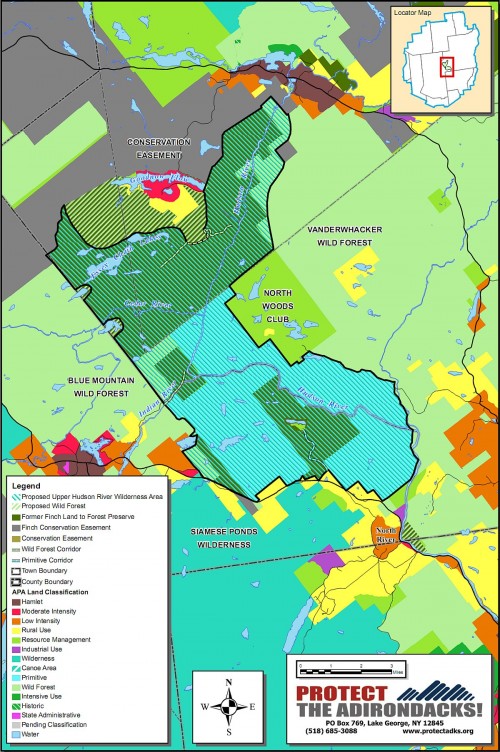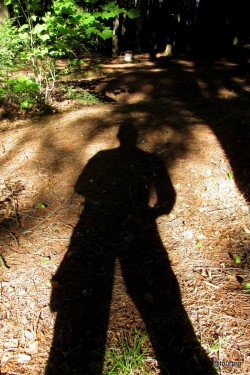Proposed ‘Wild Rivers Wilderness’ is Last Location East of Rocky Mountains Where Dream of Wilderness w/More than 60 Miles of Wild Waterways Can be Realized
New Area Would Protect 72,000 Acres Rich in Wildlife, Wetlands & Whitewater Other Parcels Enlarge High Peaks Wilderness in North & Expand Snowmobiling in South NY State Can Create a New Wilderness Area in Adirondack Park Spectacular as Grand Canyon, Yosemite & Minnesota Lakes
Newcomb, NY – The Adirondack Park’s largest and most influential environmental organization is urging state officials to create a large, new Wild Rivers Wilderness Area here that would combine the grandeur and dramatic beauty of Yellowstone, with the waterfalls of Yosemite National Park and the interconnected lakes and ponds of Minnesota’s Boundary Waters Canoe Area.
 “This is an opportunity that will never come again,” said The Adirondack Council Acting Executive Director Diane W. Fish. “This land has been off-limits to the public since before the Civil War. It is located within a day’s drive of more than 70 million Americans and Canadians. It contains no homes and no communities. The roads on these parcels will revert to foot trails quite easily. We urge the state to protect these soon-to-be-acquired lands, lakes and rivers to safeguard wildlife habitat and water quality and from overuse and motorized traffic.”
“This is an opportunity that will never come again,” said The Adirondack Council Acting Executive Director Diane W. Fish. “This land has been off-limits to the public since before the Civil War. It is located within a day’s drive of more than 70 million Americans and Canadians. It contains no homes and no communities. The roads on these parcels will revert to foot trails quite easily. We urge the state to protect these soon-to-be-acquired lands, lakes and rivers to safeguard wildlife habitat and water quality and from overuse and motorized traffic.”
Fish said the Adirondack Council sent a letter to state Environmental Conservation Commissioner Joe Martens, Thursday (December 6), calling for the creation of a vast, new Wild Rivers Wilderness Area, and a major expansion of the existing High Peaks Wilderness, when the state completes its purchase of 69,000 acres formerly owned by papermakers Finch, Pruyn & Co., of Glens Falls.
Wild Rivers Wilderness
“Our plan calls for a brand-new Wild Rivers Wilderness Area around the Essex Chain of Lakes, the Hudson River Gorge, Blue Ledges, and OK Slip Falls,” said Fish. “When purchased, these new parcels would be combined with existing sections of the Blue Mountain Lake Wild Forest and the Vanderwacker Mountain Wild Forest, as well as all of the existing Hudson Gorge Primitive Area, to create a stunningly beautiful paddlers paradise among the state’s tallest mountains. It would include 48 miles of wild rivers, plus nine interconnected lakes and ponds, as well as the Adirondack Park’s most majestic waterfall.
“More important are the rich variety of wildlife, the forests, wetlands, and fisheries this new Wilderness would protect,” Fish explained. “The foremost duty of the state, according to the State Land Master Plan, is to protect the rare natural resources on these lands from potential overuse, pollution, noise and invasive species that motorized traffic would bring. There are many ways to gain access to wild lands and waters without driving automobiles directly into the center of them. Creative solutions can be found.
“The Adirondack Park is the largest, intact deciduous forest in the world,” Fish said. “It is to oak, maple and beech forests what the Serengeti is to African grasslands, or what the Great Barrier Reef is to coral islands. We must be excellent stewards of these new public lands from the moment they come into our possession and plan carefully for their long-term health. They will return dividends in the future that we can barely comprehend today. There are seven billion people on this planet as of March 2012. Wild lands and waters are getting rarer every day.”
Ample Accommodation for Motorized Access & Community Development
Fish reminded the commissioner that more than 90,000 acres of former Finch lands had been protected from development by conservation agreements with new private owners, which allow motorized public access and sustainable harvesting. Those lands are near the lands being purchased for addition to the public Forest Preserve.
The Council is proposing that less than 50,000 acres of the former Finch lands become Wilderness. That would mean another 18,000-plus acres of former Finch lands being purchased for the Forest Preserve would be eligible for motorized access too. In addition, some former Finch lands were sold to the communities that hosted them. Some of those lands will be developed.
In sum, the Council’s proposal calls for only about one-third of Finch’s 161,000-acre former holdings to become Wilderness. Fish challenged Commissioner Martens to see this purchase as a part of a larger plan for the rational completion of the Adirondack Forest Preserve and sought to reassure him that designating an area as Wilderness will not prevent its use.
Keene and Lake Placid are surrounded by five major Wilderness areas (High Peaks, Sentinel Range, Dix Mountain, McKenzie Mountain and Giant Mountain), yet are among the park’s most prosperous communities.
Bringing the edge of the High Peaks Wilderness closer, and adding the Wild Rivers Wilderness nearby, will benefit the communities of Newcomb, North Hudson and Indian Lake for generations to come, she said.
High Peaks Wilderness Expansion
The Adirondack Council also proposed an expansion of the High Peaks Wilderness, which is by far the most popular and overused section of Forest Preserve in the Adirondack Park. The expansion would include the Boreas Ponds section of the Finch purchase, along with existing state lands not now managed as Wilderness.
Southern Parcels and Snowmobiles
In the southern Adirondacks, the Council is proposing an expansion of the Shaker Mountain Wild Forest in Benson by more than 2,000 acres, as well as an expansion of the existing Lake Desolation Wild Forest (Kayaderosseras Hills Wild Forest in 2020 VISION) east of Great Sacandaga Lake by adding the Thousand Acre Swamp. Both parcels are slated for state snowmobile trails on existing logging roads.
Other Finch Parcels
The Council’s letter to the commissioner contained recommendations on all 69,000 acres the state intends to acquire over the next five years from The Nature Conservancy. A copy of the letter and detailed maps of the areas described may be viewed at www.AdirondackCouncil.org.
Adirondack Park vs. Adirondack Forest Preserve
The Adirondack Park is a 9,300-square-mile (six-million-acre) preserve of public and private lands. Public lands make up about half of the park (2.7 million acres). Timberlands, private homes and 130 small communities make up the other half. Public and private lands are intermixed.
All state lands in the Adirondack Park are protected by a section of the State Constitution known as the Forever Wild Clause, which bans their lease, sale or development, as well as logging or destruction of public forests. These lands are known as Forest Preserve.
Not all public Forest Preserve is Wilderness. Less than half of the Forest Preserve – about one million acres – is managed as Wilderness, where no motorized or mechanized travel is allowed. These one million acres represent about 90 percent of all Wilderness areas remaining in the Northeast.
Council’s Plan Created in 1988
“We have been anticipating this opportunity for almost 25 years,” said Fish. “Back in 1988, we conducted the first comprehensive survey of the private Adirondack lands and recommended which lands the state should acquire (when they became available or from willing sellers) to complete the Adirondack Forest Preserve. The first three volumes of our 2020 VISION reports were completed by 1992, and became the backbone of the Adirondack portion of the NYS Open Space Conservation Plan. But our plans were sitting on a shelf until Finch, Pruyn & Co. sold its lands in 2007, and the Governor agreed to buy 69,000 acres of them in August.”
2020 VISION
The Wilderness protection plans collected in 2020 VISION: Volumes I & II are the work product of more than a decade of research by NYS Conservation Department Wildlife Biologist Greenleaf Chase; Plant Ecologist Dr. Edwin Ketchledge of the SUNY College of Environmental Science and Forestry; Adirondack Park Agency Forest Preserve Specialist Clarence Petty; and, Harold A. Jerry, a State Senator and Executive Director of Gov. Nelson Rockefeller’s Temporary Study Commission on the Future of the Adirondack Park. This work was collected, illustrated and published by Adirondack Council Executive Director and professional planner George D. Davis, whose conservation planning efforts – including these – earned him the prestigious Genius Award from the John D. and Catherine T. MacArthur Foundation.
Founded in 1975, the Adirondack Council is a privately funded, not-for-profit organization dedicated to ensuring the ecological integrity and wild character of the Adirondack Park. The Council carries out its mission through research, education, advocacy and legal action. Adirondack Council members live in all 50 United States.






